Coastal Flooding Associated with Hurricane Irma in Central Cuba (Ciego de Ávila Province)
Abstract
:1. Introduction
2. Materials and Methods
2.1. General Methodological Aspects
2.2. Study Area
3. Results
3.1. Hurricane Irma’s Path over the Study Area, Overview
3.2. Spatial Distribution of Coastal Flooding
3.3. Coastal Flooding Associated with Hurricane Irma—Comparison with Previously Modeled Hazard Scenarios
3.4. Socioeconomic Effects of Hurricane Irma on the Constituencies of Venezuela and Chambas
4. Discussion
5. Conclusions
Author Contributions
Funding
Institutional Review Board Statement
Informed Consent Statement
Data Availability Statement
Acknowledgments
Conflicts of Interest
References
- IPCC. Cambio climático 2014. Impactos, adaptación y vulnerabilidad. In Field; Barros, C.V., Jon Dokken, V.R., Mach, D., Mastrandrea, K.J., Bilir, M.D., Chatterjee, T.E., Ebi, M., Otsuki Estrada, K.L., Genova, Y., Girma, R.C., et al., Eds.; Copa: Geneva, Switzerland, 2014. [Google Scholar]
- Furrazola, G.F.; Núñez, K.E. Estudios Sobre Geología de Cuba/Compilación; Centro Nacional de Información Geológica (CNDIG), Ed.; Instituto de Geología y Paleontología: La Habana, Cuba, 1997; pp. 509–527. [Google Scholar]
- Mitrani, I. Las Inundaciones Costeras en Cuba y su Repercusión Social. Bioética/Septiembre–Diciembre, 2006. Available online: http://www.cbioetica.org/revista/63/630410.pdf (accessed on 17 October 2019).
- Iturralde-Vinent, M.A. Huracanolitos, Eventos de Oleaje Extremo y Protección de las Obras Costeras. 2017. Available online: http://www.redciencia.cu/geobiblio/inicio.html (accessed on 18 July 2020).
- Mitrani, I.; Fontova, M.; Díaz, L.; González, J. Determinación del Régimen de Ola y Viento en la Costa Norte de la Habana. IV Exposición Forjadores Del Futuro; Centro de Información y Divulgación de las BTJ: La Habana, Cuba, 1986; 15p. [Google Scholar]
- Mitrani, I.; Díaz, L.; Pérez, P.; González, J. Características Hidrometeorológicas Generales de la Zona Costera Correspondiente al Malecón Habanero: Informe de Resultado Científico; Biblioteca INSMET: La Habana, Cuba, 1994; 38p. [Google Scholar]
- Portela, M. Elaboración de un Método Sinóptico–Estadístico Para el Pronóstico de la Ocurrencia de Inundaciones Costeras en Cuba; Proyecto Cuba/94/003; Instituto de Meteorología—PNUD: La Habana, Cuba, 1998; pp. 46–63. [Google Scholar]
- Pérez-Osorio, P.J.; Casals, R.; del Sol, A.; Díaz, L. Análisis de los fenómenos meteorológicos que provocaron penetraciones del mar en el malecón habanero. Rev. Cuba. Meteorol. 2001, 8, 50–58. [Google Scholar]
- Casals, R. Cronología de las inundaciones costeras ocurridas en el sur de la provincia La Habana. Rev. Cuba. Meteorol. 2002, 9, 90–95. [Google Scholar]
- Regueira, V.A.; Barcia, S. Cronología de inundaciones costeras por penetración del mar, en la provincia Cienfuegos. Rev. Cuba. Meteorol. 2019, 25, 278–290. [Google Scholar]
- Hidalgo, A.; Hernández, N.; Perigó, E. Períodos de retorno para las inundaciones costeras y los eventos extremos de viento y oleaje en la costa nororiental de Cuba. Rev. Cuba. Meteorol. 2019, 25, 191–202. [Google Scholar]
- Hidalgo, A. Metodología para el Estudio Climático de las Inundaciones Costeras en Cuba. Master’s Thesis, Instituto Superior de Tecnologías y Ciencias Aplicadas (InSTEC), La Habana, Cuba, 2016; 73p. [Google Scholar]
- Casals, R.; Pérez, P.; Menéndez, L. Análisis de las inundaciones costeras ocurridas en áreas protegidas de Cuba en el período 1981–2010. Rev. Cuba. Meteorol. 2016, 22, 199–215. [Google Scholar]
- Hidalgo, A.; Mitrani, I.; Pérez, G. Nueva clasificación de las inundaciones costeras en Cuba. Rev. Cuba. Meteorol. 2017, 23, 209–216. [Google Scholar]
- Córdova, O.L.; García, M.; López, A. Cronología de las inundaciones costeras en la provincia de Ciego de Ávila. Período 1960–2017. Rev. Cuba. Meteorol. 2018, 24, 136–145. [Google Scholar]
- Matos-Pupo, F.; Peros, M.; Rodríguez, Y.; Hernández-Fernández, L.; Guash, F. Depósitos de huracanolitos en Jardines de la Reina (Cuba) provocados por oleajes extremos: Paleohuracanes o paleotsunamis? In Proceedings of the XI Congreso de Ciencias del Mar (MarCuba), Palacio de Convenciones, La Habana, Cuba, 15–19 October 2018. Available online: http://www.congresomarcuba.com (accessed on 17 October 2019).
- Pérez, R.; Vega, R.; Limia, M. Los huracanes más intensos y desastrosos de Cuba en los últimos dos siglos. Bol. Soc. Meteorol. Cuba. 2001, 7, 9p. [Google Scholar]
- AMA. Lineamientos Metodológicos para la Realización de los Estudios de Peligro, Vulnerabilidad y Riesgos de Desastre de Inundación por Penetración del Mar, Inundaciones por Intensas Lluvias y Afectaciones por Fuertes Vientos; Agencia de Medio Ambiente, CITMA: Havana, Cuba, 2008. [Google Scholar]
- Córdova, O.L.; García, M.; Machado, A.; Borrego, R. Huracanes que afectaron a Ciego de Ávila y sus periodos de retorno. Periodo 1851 a 2017. Rev. Cuba. Meteorol. 2018, 24, 245–255. [Google Scholar]
- Matos, F.; López, O.E.P.; Jorge, A.V. Hurricane Related Coastal Flooding in the Province of Ciego de Avila, Cuba: Hazard, Vulnerability and Risk Study. In Proceedings of the 3rd International Conference on BioGeoSciences; Cayos de Santa Maria, Villa Clara, Cuba, 23–30 June 2019; Cardenas, R., Mochalov, V., Parra, O., Martin, O., Eds.; Springer Proceedings in Earth and Environmental Sciences. Springer: Cham, Swizterland, 2022. [Google Scholar] [CrossRef]
- UMA. Informe de Evaluación del Impacto Ambiental de Desastre Provocado por Irma (Huracán de Gran Intensidad) en la Provincia Ciego de Ávila; Unidad De Medio Ambiente CITMA Ciego de Ávila: Ciego de Ávila, Cuba, 2017; 33p. [Google Scholar]
- Centro de Inspección y Control Ambiental (CICA). Guías para la Realización de las Solicitudes de Licencia Ambiental y los Estudios de Impacto Ambiental; Editorial CITMA: Havana, Cuba, 2009; 94p. [Google Scholar]
- Iturralde-Vinent, M.A. Compendio de Geología de Cuba y el Caribe, 2nd ed.; CITMATEL (Empresa de Tecnologías de la Información y Servicios Telemáticos Avanzados): La Habana, Cuba, 2012. [Google Scholar]
- Pardo, M.E. (Ed.) Geology of Cuba. In Regional Geology Reviews; Springer: Berlin/Heidelberg, Germany, 2021; 332p. [Google Scholar] [CrossRef]
- Gómez-Martín, M.B.; Matos-Pupo, F.; Bada-Díaz, R.; Escalante-Pérez, D. Assessing Present and Future Climate Conditions for Beach Tourism in Jardines del Rey (Cuba). Atmosphere 2020, 11, 1295. [Google Scholar] [CrossRef]
- ONEI. Anuario Estadístico de Cuba 2020. Agricultura, Ganaderia, Silvicultura y Pesca. 2021. Available online: https://www.onei.gob.cu/sites/default/files/agropecuario_-2020_0.pdf (accessed on 3 September 2023).
- ONEI. Anuario Nacional de Estadística. 2017. Available online: http://www.onei.gob.cu (accessed on 19 October 2022).
- ONEI. Censo de Población y Viviendas. 2012. Available online: http://onei.gob.cu/publicaciones-censos (accessed on 18 March 2022).
- Cangialosi, J.P.; Latto, A.S.; Berg, R. National Hurricane Center Tropical Cyclone Report, Hurricane Irma (AL112017); National Hurricane Center, National Oceanic and Atmospheric Administration: Miami, FL, USA, 2021. Available online: https://www.nhc.noaa.gov/data/tcr/AL112017_Irma.pdf (accessed on 4 March 2023).
- Barcia-Sardiñas, S.; Fontes-Leandro, M.; Ramírez-González, M.; Viera-González, E.Y. La sequía meteorológica 2014–1017, características e impactos en la provincia Cienfuegos. Rev. Cuba. Meteorol. 2019, 25, 319–333. [Google Scholar]
- Valero-Jorge, A.; González-De Zayas, R.; Alcántara-Martín, A.; Álvarez-Taboada, F.; Matos-Pupo, F.; Brown-Manrique, O. Water area and volume calculation of two reservoirs in Central Cuba using remote sensing methods. A new perspective. Rev. Teledetección 2022, 60, 71–87. [Google Scholar] [CrossRef]
- CENAPRED. Facículo de Ciclonestropicales. 2003. Available online: https://www.gob.mx/cenapred/documentos/fasciculo-ciclones-tropicales (accessed on 5 March 2022).
- Frank, N.L.; Husain, S.A. The deadliest tropical cyclone in history? Bull. Am. Meteorol. Soc. 1971, 52, 438–444. [Google Scholar] [CrossRef]
- Rosengaus, M. Efectos Destructivos de Ciclones Tropicales; MAPFRE: Mexico City, Mexico, 1998; Available online: https://www.mapfrere.com/publicaciones/efectos-destructivos-ciclones-tropicales/ (accessed on 5 March 2022).
- Moreno-Suárez, O.; Rodríguez-Ríos, Y.; Matos-Pupo, F.; López-Mayea, A.; González-Abreu, R.; Rodríguez-Cueto, Y.; González-Ramírez, I.; Rodríguez-Zayas, M.; Hernández-Hernández, S.; Vidal-Olivera, V.; et al. Estudio de Peligro, Vulnerabilidad y Riesgos de Desastres de Inundaciones por penetraciones del Mar, Inundaciones por Intensas Lluvias y Afectaciones por Fuertes Vientos en la Provincia Ciego de Ávila; Ministerio de Ciencia, Tecnología y Medio Ambiente (CITMA): Ciego de Ávila, Cuba, 2011; 118p. [Google Scholar]
- AMA. Escenarios de Peligro y Vulnerabilidad de la Zona Costera Cubana, Asociados al Ascenso del Nivel Medio del Mar para los Años 2050 y 2100; Resumen anual de los resultados del Macro Proyecto; Agencia de Medio Ambiente: La Habana, Cuba, 2019. [Google Scholar]
- Planos, E.O.; Gutiérrez, T. (Eds.) Tercera Comunicación Nacional a la Convención Marco de Naciones Unidas Sobre Cambio Climático; CITMA: Ciego de Ávila, Cuba, 2020; 403p. [Google Scholar]
- Liu, H.; Zhang, H.; Li, Y.; Xie, L. Numerical study of the sensitivity of mangroves in reducing storm surge and flooding to hurricane characteristics in southern Florida. Cont. Shelf Res. 2013, 64, 51–65. [Google Scholar] [CrossRef]
- Marino-Tapia, I.; Enriquez, C.; Mendoza Baldwin, E.; Escalante Mancera, E. Comparative Morphodynamics between Exposed and Reef Protected Beaches under Hurricane Conditions. Coast. Eng. 2014, 34, 1–9. [Google Scholar] [CrossRef]
- Imbert, D. Hurricane disturbance and forest dynamics in east Caribbean mangroves. Ecosphere 2018, 9, e02231. [Google Scholar] [CrossRef]
- Elsner, J.B.; Kossin, J.P.; Jagger, T.H. The increasing intensity of the strongest tropical cyclones. Nature 2008, 455, 92–95. [Google Scholar] [CrossRef]
- Knutson, T.R.; McBride, J.L.; Chan, J.; Emanuel, K.; Holland, G.; Landsea, C.; Held, I.; Kossin, J.P.; Srivastava, A.K.; Sugi, M. Tropical cyclones and climate change. Nat. Geosci. 2010, 3, 157–163. [Google Scholar] [CrossRef]
- Rey, T.; Leone, F.; Candela, T.; Belmadani, A.; Palany, P.; Krien, Y.; Cécé, R.; Gherardi, M.; Péroche, M.; Zahibo, N. Coastal Processes and Influence on Damage to Urban Structures during Hurricane Irma (St-Martin & St-Barthélemy, French West Indies). J. Mar. Sci. Eng. 2019, 7, 215. [Google Scholar] [CrossRef]
- Walker, R.; Laplanche, C.; Herteman, M.; Lambs, L.; Fromard, F. Damages caused by hurricane Irma in the human-degraded mangroves of Saint Martin (Caribbean). Sci. Rep. 2019, 9, 18971. [Google Scholar] [CrossRef]
- Zhang, K.; Liu, H.; Li, Y.; Xu, H.; Shen, J.; Rhome, J.; Smith, T.J. The role of mangroves in attenuating storm surges. Estuar. Coast. Shelf Sci. 2012, 102–103, 11–23. [Google Scholar] [CrossRef]
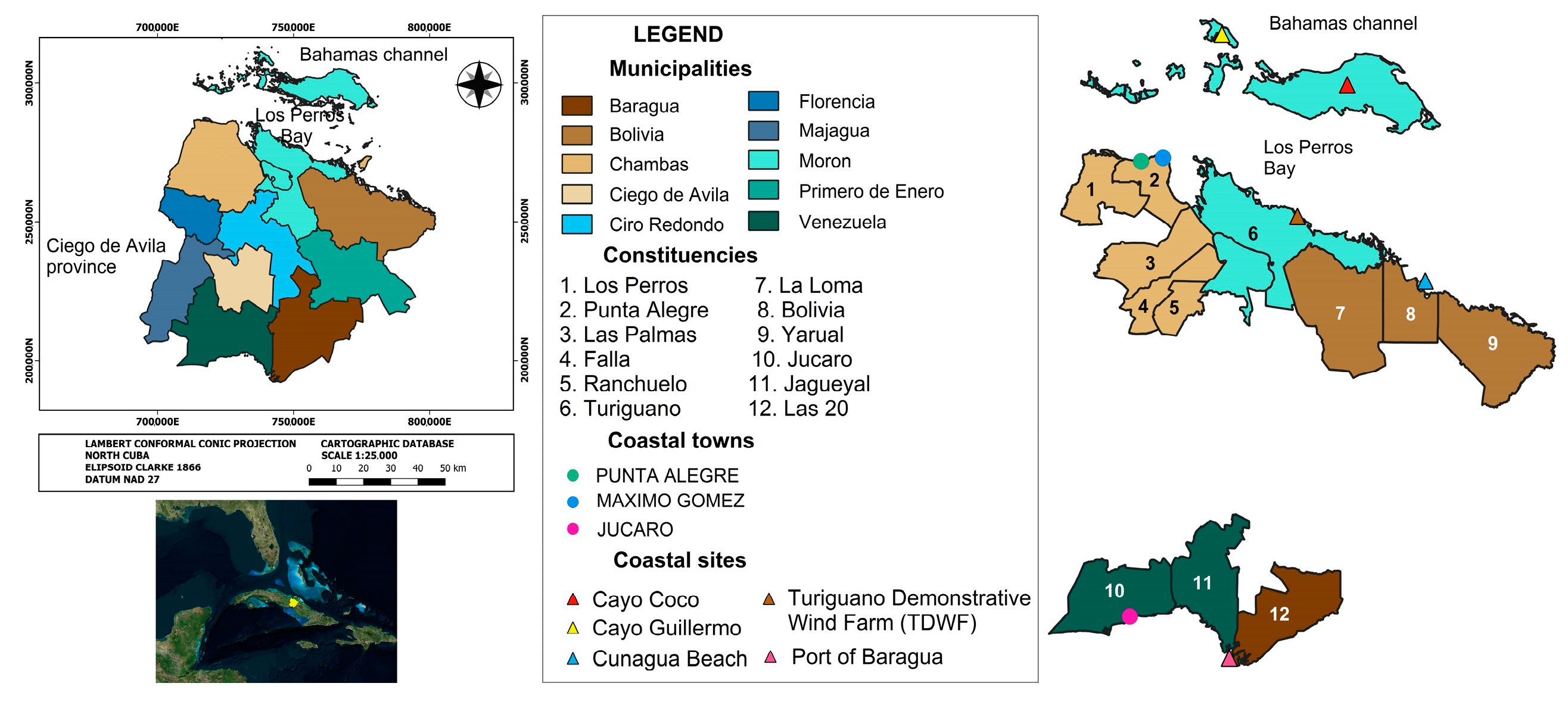
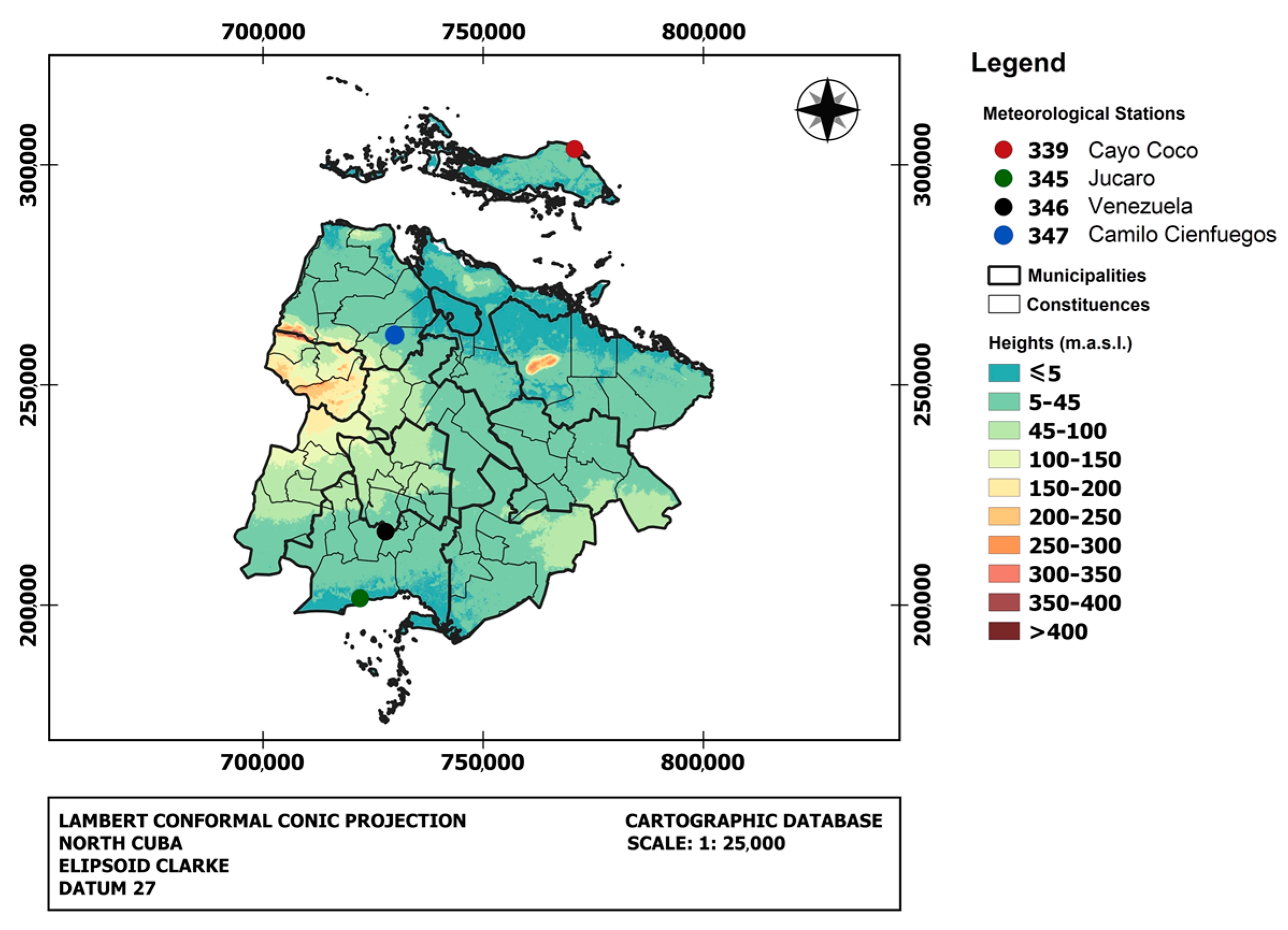

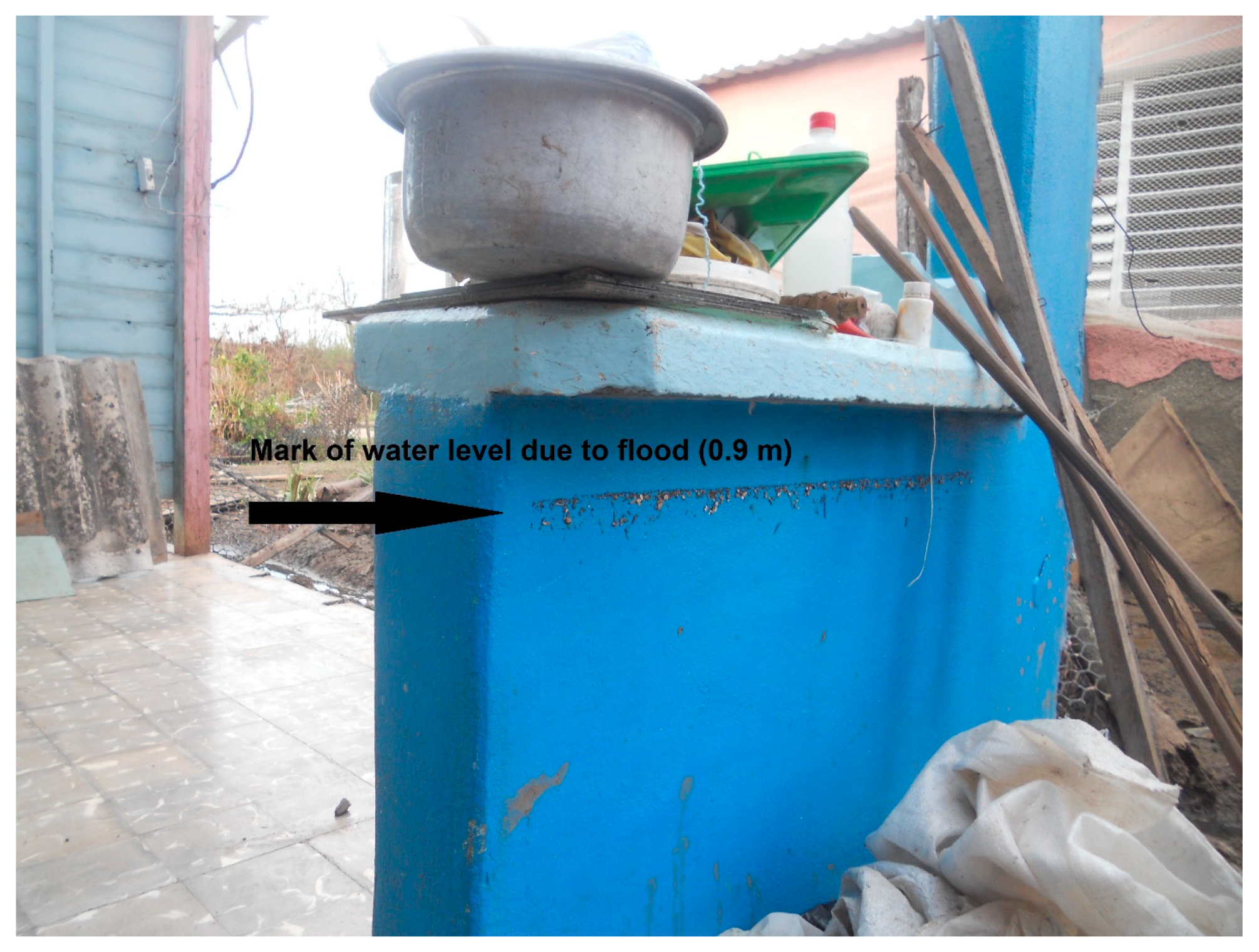

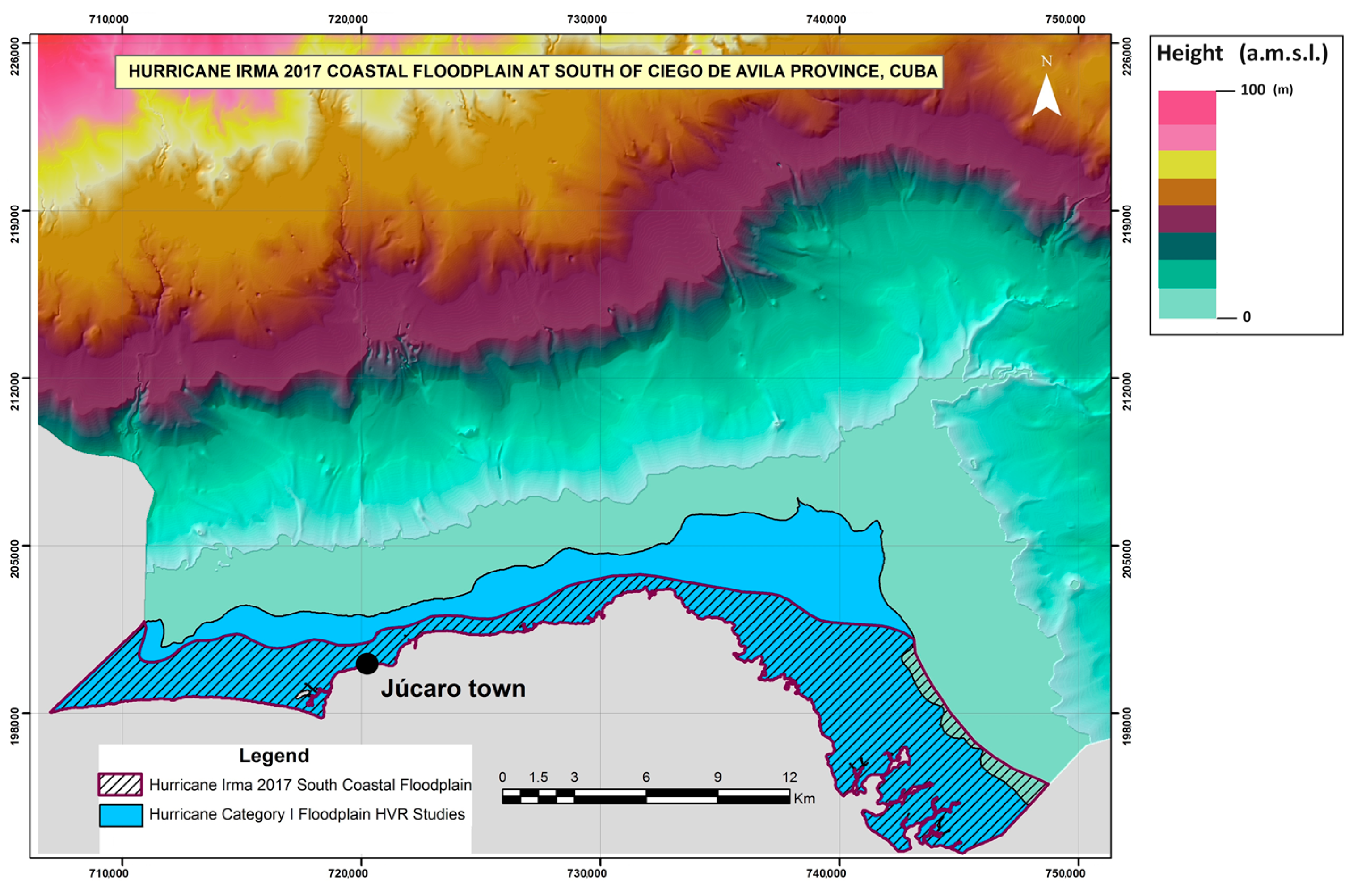
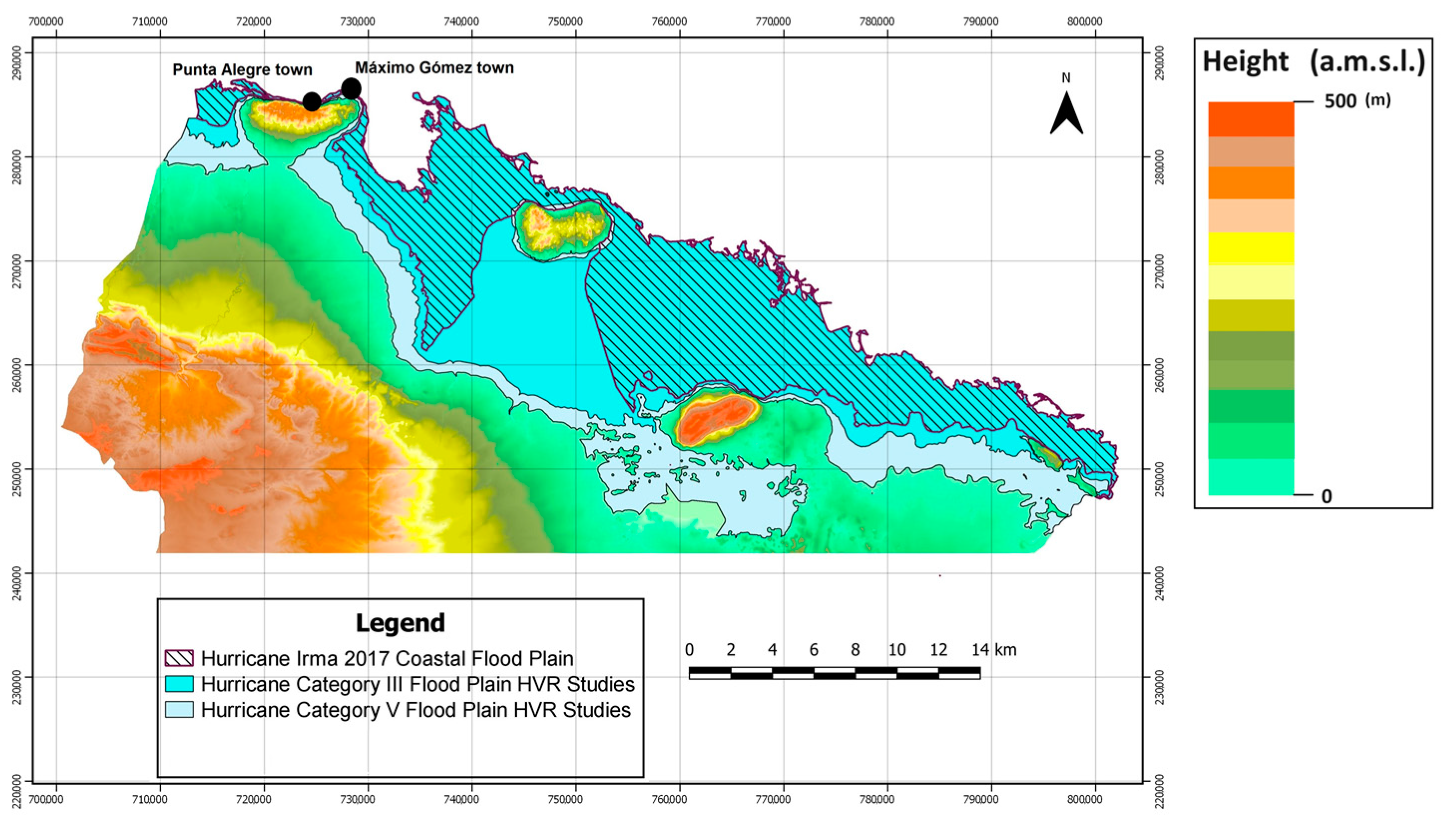
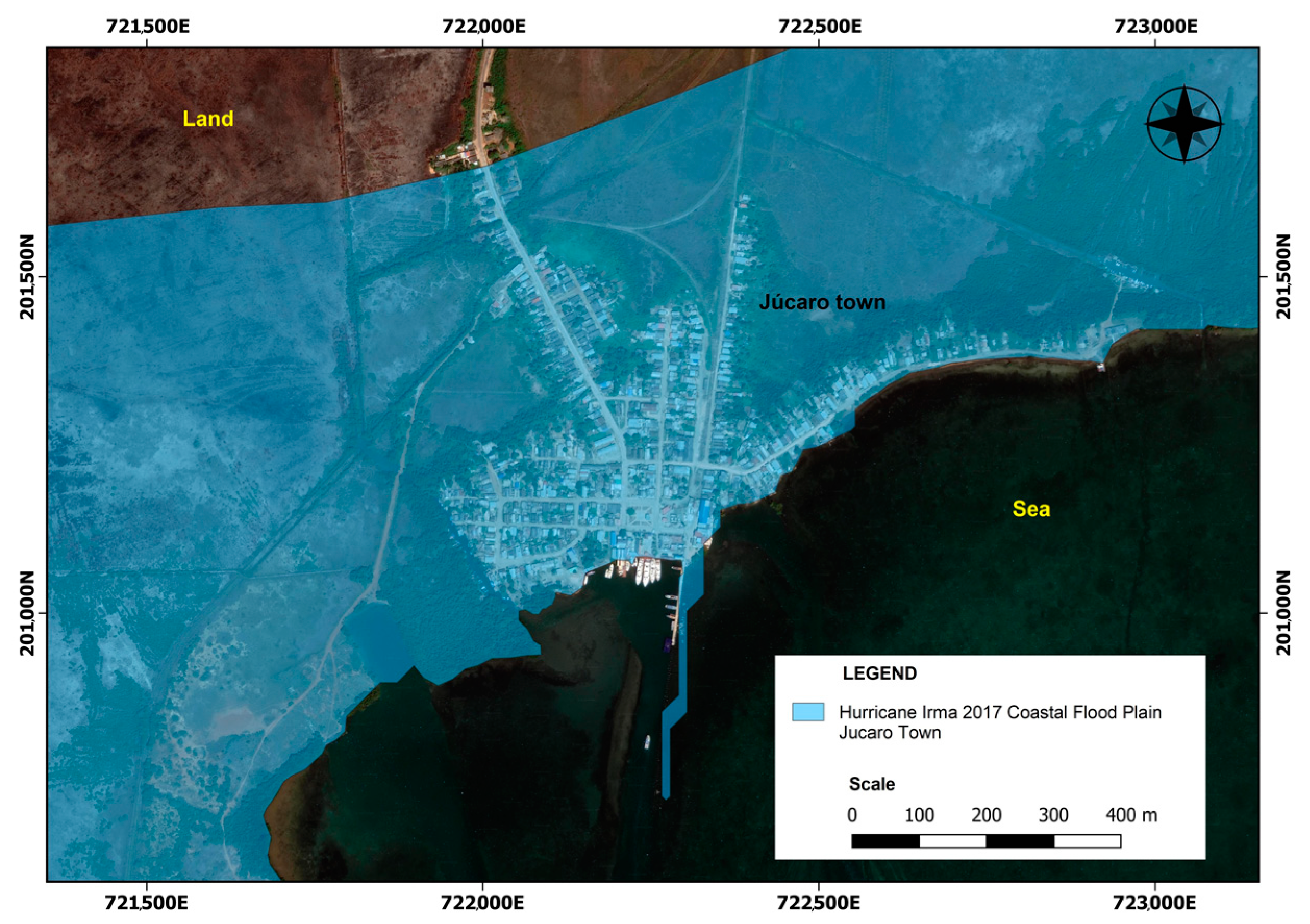
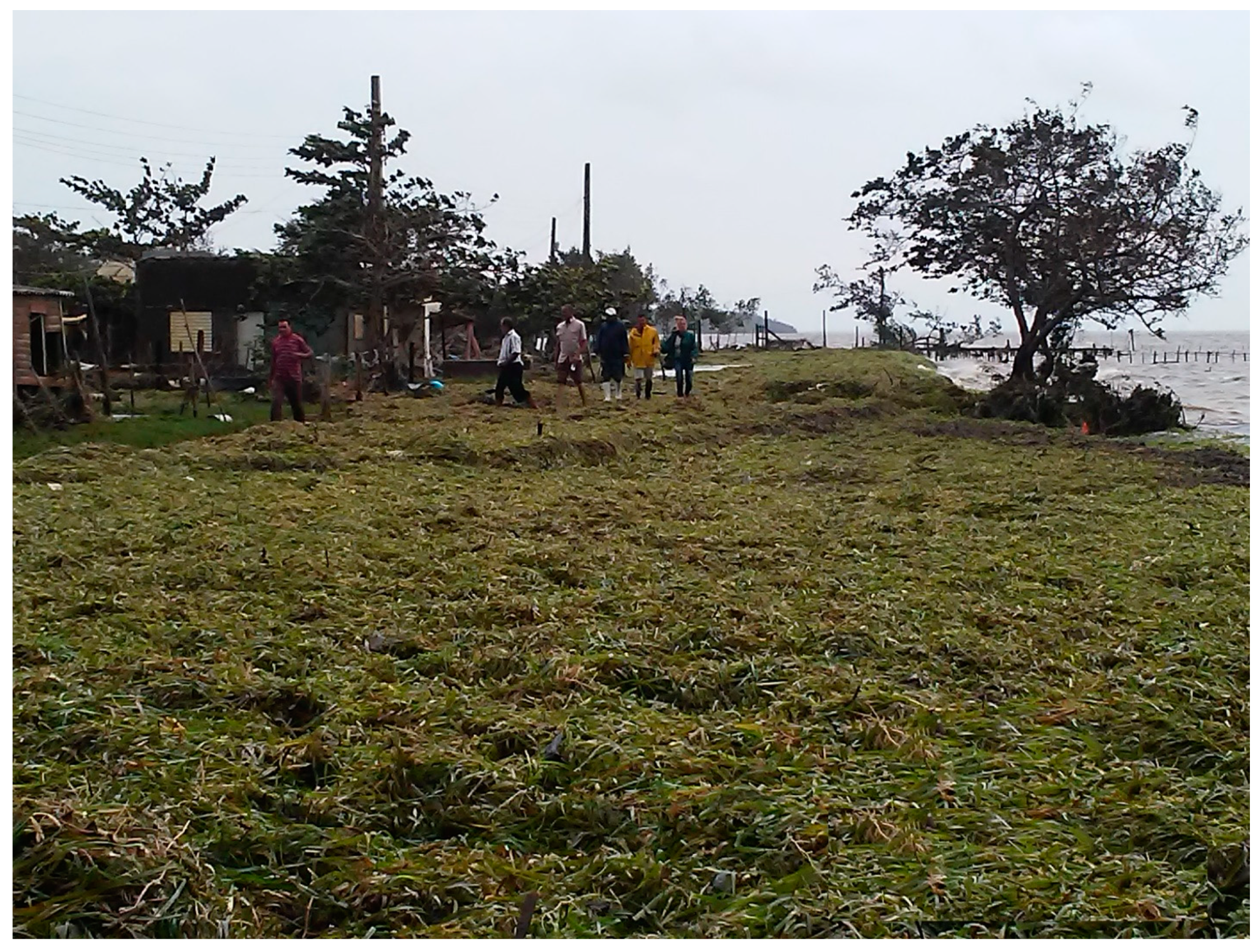
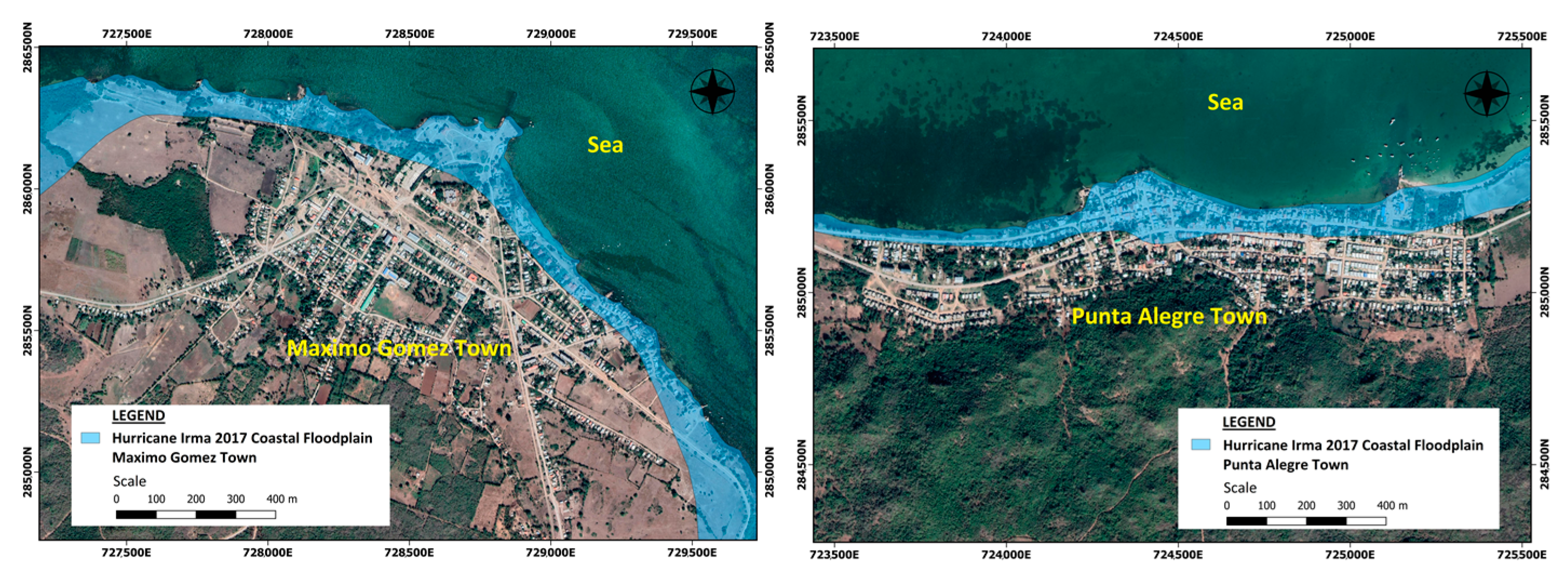

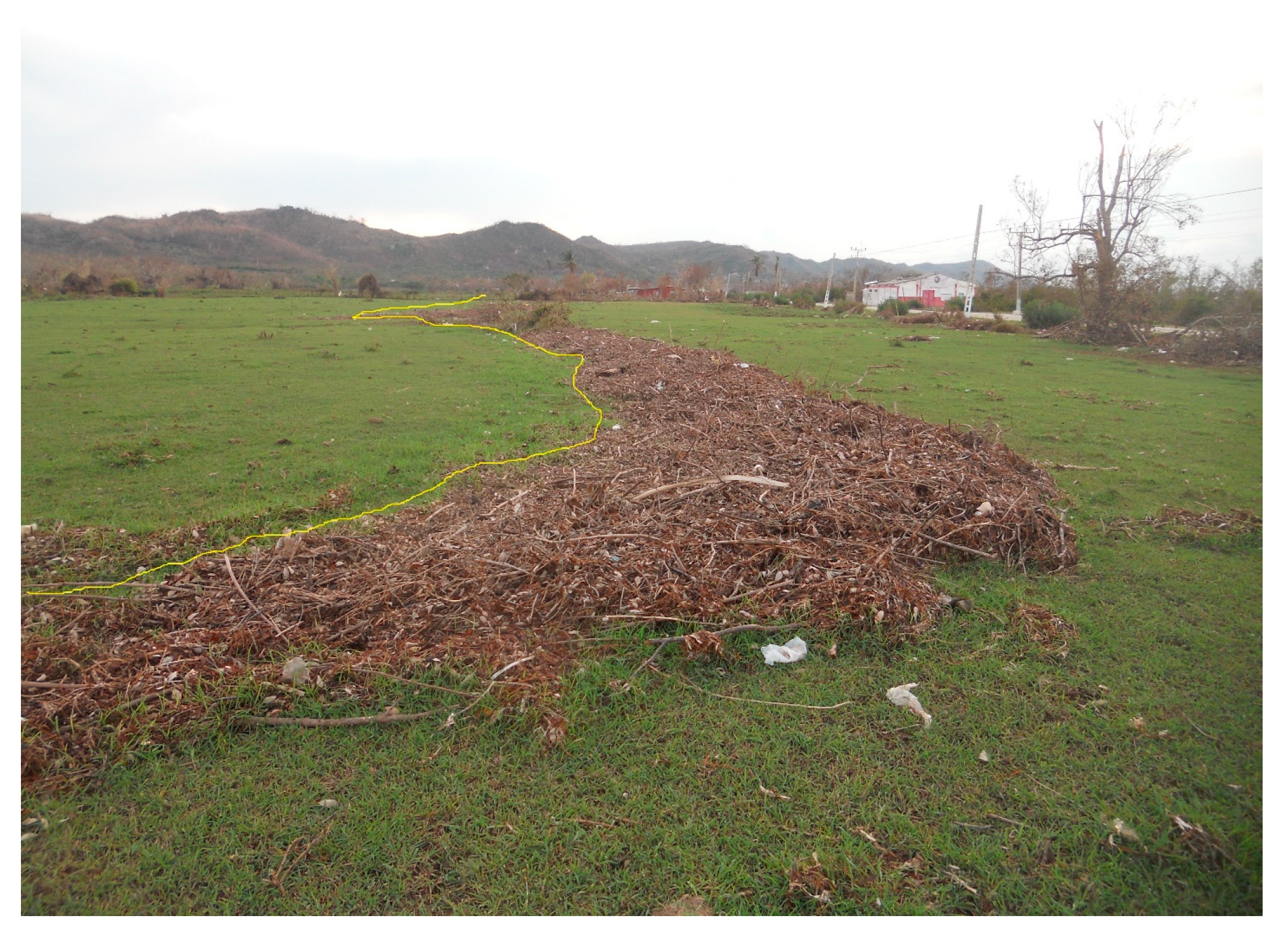
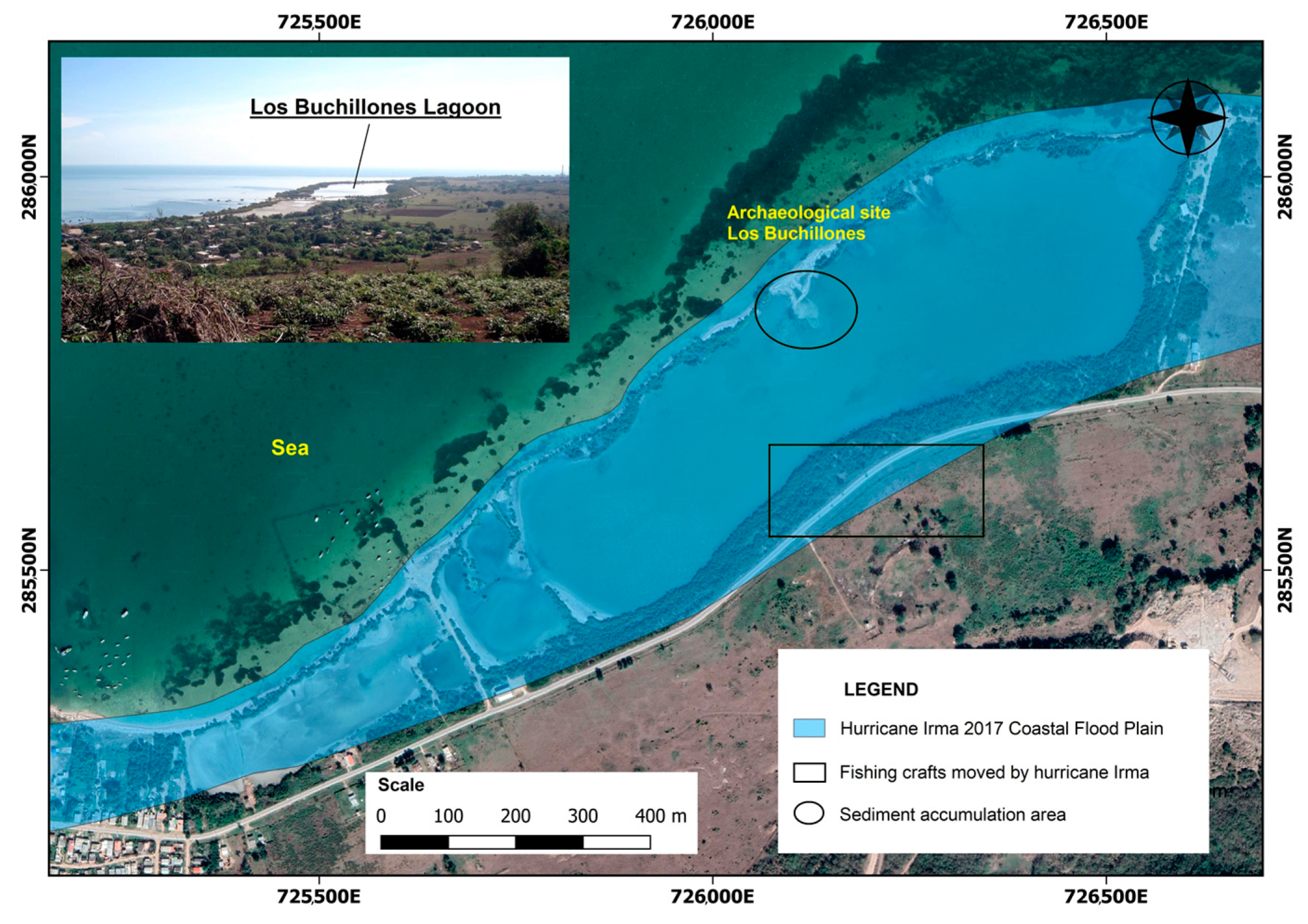
| Indicator | Value | Comments |
|---|---|---|
| The total area of the province (km2), including the keys | 6971.63 | 776 keys (north cost: 654; south coast: 122) |
| Area (km2) considered for this study | 6124.69 | Keys not included |
| Coast length (km) | 338.00 | Northern coast: 265. Southern coast: 73 |
| Coast length (km) considered for this study | 268.70 | Coasts of the keys not included |
| Municipalities (units) | 10 | |
| Constituencies (units) | 62 |
| Coastal Zone | Coordinates | Coast | Municipality | Day/h of Flood Beginning |
|---|---|---|---|---|
| Cunagua Beach | 22.18° N; 78.32° W | North | Bolivia | 8/10:00 pm |
| Cayo Coco | 22.48° N; 78.49° W | North | Morón | 8/11:30 pm |
| Cayo Guillermo | 22.57° N; 78.69° W | North | Morón | 8/11:50 pm * |
| TDWF | 22.29° N; 78.58° W | North | Morón | 9/12:20 am |
| Punta Alegre | 22.38° N; 78.82° W | North | Chambas | 9/02:00 am |
| Port of Baraguá | 21.53° N; 78.65° W | South | Baraguá | 9/02:30 am * |
| Júcaro | 21.63° N; 78.83° W | South | Venezuela | 9/03:05 am |
| Municipality | Constituency | Area (km2) | Irma Floodplain (km2) | Irma Floodplain (%) |
|---|---|---|---|---|
| Chambas | Los Perros | 124.40 | 15.60 | 12.5 |
| Chambas | Punta Alegre | 86.06 | 21.00 | 24.4 |
| Chambas | Las Palmas | 155.60 | 50.10 | 32.2 |
| Chambas | Falla | 94.81 | 20.80 | 21.9 |
| Chambas | Ranchuelo | 62.42 | 1.70 | 2.7 |
| Morón | Turiguanó | 295.90 | 204.90 | 69.2 |
| Bolivia | La Loma | 306.60 | 164.70 | 53.7 |
| Bolivia | Bolivia | 124.30 | 78.60 | 63.2 |
| Bolivia | Yarual | 251.70 | 87.20 | 34.6 |
| Venezuela | Júcaro | 208.70 | 38.00 | 18.2 |
| Venezuela | Jagüeyal | 204.60 | 36.00 | 17.6 |
| Baraguá | Las 20 | 201.80 | 29.00 | 14.4 |
| Municipality | Area (km2) | Floodplain HVR Studies (Hurricane Categories) | Hurricane Irma Floodplain (km2) | ||
|---|---|---|---|---|---|
| Category H1 (km2) | Category H3 (km2) | Category H5 (km2) | |||
| North Coast | |||||
| Chambas | 772.43 | 122.94 | 208.30 | 109.20 | |
| Morón | 587.30 | 377.64 | 442.50 | 204.90 | |
| Bolivia | 892.30 | 390.77 | 561.90 | 330.50 | |
| Primero de Enero | 512.72 | 0.00 | 0.20 | 0.00 | |
| Ciro Redondo | 581.15 | 0.36 | 0.70 | 0.00 | |
| South Coast | |||||
| Venezuela | 699.74 | 130.29 | 74.00 | ||
| Baraguá | 781.70 | 24.06 | 29.00 | ||
| Damage Data | Júcaro | Punta Alegre |
|---|---|---|
| Area (km2) | 208.70 | 86.06 |
| Coastal floodplain/Irma (km2) | 38.00 | 21.00 |
| Total number of houses | 781 | 2017 |
| Houses totally affected | 97 | 200 |
| Houses partially affected | 33 | 75 |
| Roofs affected (total) | 5 | 25 |
| Roofs affected (partial) | 89 | 82 |
| Houses affected | 224 | 382 |
| Houses affected (%) | 28.7 | 18.9 |
| Population | 2696 | 6724 |
| Affected population | 623 | 1272 |
| Affected population (%) | 23.1 | 18.9 |
| Number of affected/Territorial area | 3 | 15 |
| Number of affected/Flooded area | 16 | 60 |
| Country | Site | Location | Minimum Sea Level Pressure | Maximum Surface Wind Speed | Storm Surge (m) | Storm Tide (m) | Source | |||
|---|---|---|---|---|---|---|---|---|---|---|
| Date/Time (UTC) | Pressure (hPa) | Date/Time (UTC) | Sustained (km/h) | Gust (km/h) | ||||||
| Antigua and Barbuda | Barbuda NOS Site | 17.59N 61.82W | 06/0536 | 916.1 | 06/0454 | 194 | 257 | 2.43 | (1) | |
| U.S. Virgin Islands | Christiansted Harbor, St. Croix | 17.75N 64.71W | 06/1706 | 995.0 | 06/1642 | 61 | 93 | 0.70 | (1) | |
| Lime Tree Bay, St. Croix | 17.69N 64.75W | 06/1706 | 996.4 | 06/1848 | 80 | 98 | 0.18 | 0.24 | (1) | |
| Charlotte Amalie, St. Thomas | 18.34N 64.92W | 06/1742 | 967.5 | 06/1736 | 102 | 157 | 0.44 | 0.52 | (1) | |
| Puerto Rico | Esperanza, Vieques Island | 18.09N 65.47W | 06/2006 | 991.9 | 06/2130 | 83 | 104 | 0.44 | 0.48 | (1) |
| La Puntilla, San Juan Bay | 18.46N 66.12W | 06/2300 | 989.3 | 06/2230 | 89 | 119 | 0.47 | 0.64 | (1) | |
| Mayaguez | 18.22N 67.16W | 07/0018 | 1001.5 | 07/0606 | 50 | 67 | 0.42 | 0.61 | (1) | |
| Arecibo | 18.48N 66.70W | 07/0036 | 998.7 | 07/0130 | 70 | 87 | 0.42 | 0.46 | (1) | |
| Cuba | Cayo Coco (78339) | 22.52N 78.45W | 09/0520 | 933.1 | 09/0500 | 185 | 194 | 2.34 | 2.65 | (2) |
| Ciego de Ávila (Punta Alegre) | 22.38N 78.81W | 09/0650 | 959.8 | 09/0635 | 230 | 256 | 1.69 | 2.00 | (2) | |
| Ciego de Ávila (Júcaro) | 21.62N 78.85W | 09/1300 | 984.3 | 09/0700 | 80 | 144 | 0.57 | 0.88 | (2) | |
| United States | Clearwater Beach | 27.98N 82.83W | 11/0606 | 976.2 | 11/0548 | 115 | 143 | 0.51 | 0.57 | (1) |
| Port Canaveral—Trident Pier | 28.42N 80.59W | 11/0700 | 990.1 | 11/0942 | 85 | 109 | 1.41 | 1.60 | (1) | |
| Cedar Key | 29.13N 83.03W | 11/0936 | 977.2 | 11/1536 | 57 | 87 | 0.79 | 0.83 | (1) | |
| Apalachicola | 29.73N 84.98W | 11/1206 | 995.6 | 11/0918 | 63 | 83 | 0.28 | 0.51 | (1) | |
| Charleston | 32.78N 79.93W | 11/1654 | 1002.8 | 11/1654 | 78 | 98 | 1.49 | 2.07 | (1) | |
| Fort Pulaski | 32.03N 80.90W | 11/1706 | 999.7 | 11/1218 | 78 | 113 | 1.72 | 2.50 | (1) | |
| Panama City | 30.15N 85.67W | 11/1942 | 999.3 | 11/1918 | 46 | 72 | 0.17 | 0.33 | (1) | |
| Pensacola | 30.40N 87.21W | 11/2054 | 1004.0 | 10/2224 | 31 | 52 | 0.31 | 0.48 | (1) | |
| Panama City Beach | 30.21N 85.88W | 11/2206 | 999.4 | 11/2218 | 54 | 70 | 0.18 | 0.39 | (1) | |
Disclaimer/Publisher’s Note: The statements, opinions and data contained in all publications are solely those of the individual author(s) and contributor(s) and not of MDPI and/or the editor(s). MDPI and/or the editor(s) disclaim responsibility for any injury to people or property resulting from any ideas, methods, instructions or products referred to in the content. |
© 2023 by the authors. Licensee MDPI, Basel, Switzerland. This article is an open access article distributed under the terms and conditions of the Creative Commons Attribution (CC BY) license (https://creativecommons.org/licenses/by/4.0/).
Share and Cite
Matos-Pupo, F.; Peros, M.C.; González-De Zayas, R.; Valero-Jorge, A.; Pérez-López, O.E.; Álvarez-Taboada, F.; Sorí, R. Coastal Flooding Associated with Hurricane Irma in Central Cuba (Ciego de Ávila Province). Atmosphere 2023, 14, 1445. https://doi.org/10.3390/atmos14091445
Matos-Pupo F, Peros MC, González-De Zayas R, Valero-Jorge A, Pérez-López OE, Álvarez-Taboada F, Sorí R. Coastal Flooding Associated with Hurricane Irma in Central Cuba (Ciego de Ávila Province). Atmosphere. 2023; 14(9):1445. https://doi.org/10.3390/atmos14091445
Chicago/Turabian StyleMatos-Pupo, Felipe, Matthew C. Peros, Roberto González-De Zayas, Alexey Valero-Jorge, Osvaldo E. Pérez-López, Flor Álvarez-Taboada, and Rogert Sorí. 2023. "Coastal Flooding Associated with Hurricane Irma in Central Cuba (Ciego de Ávila Province)" Atmosphere 14, no. 9: 1445. https://doi.org/10.3390/atmos14091445
APA StyleMatos-Pupo, F., Peros, M. C., González-De Zayas, R., Valero-Jorge, A., Pérez-López, O. E., Álvarez-Taboada, F., & Sorí, R. (2023). Coastal Flooding Associated with Hurricane Irma in Central Cuba (Ciego de Ávila Province). Atmosphere, 14(9), 1445. https://doi.org/10.3390/atmos14091445











